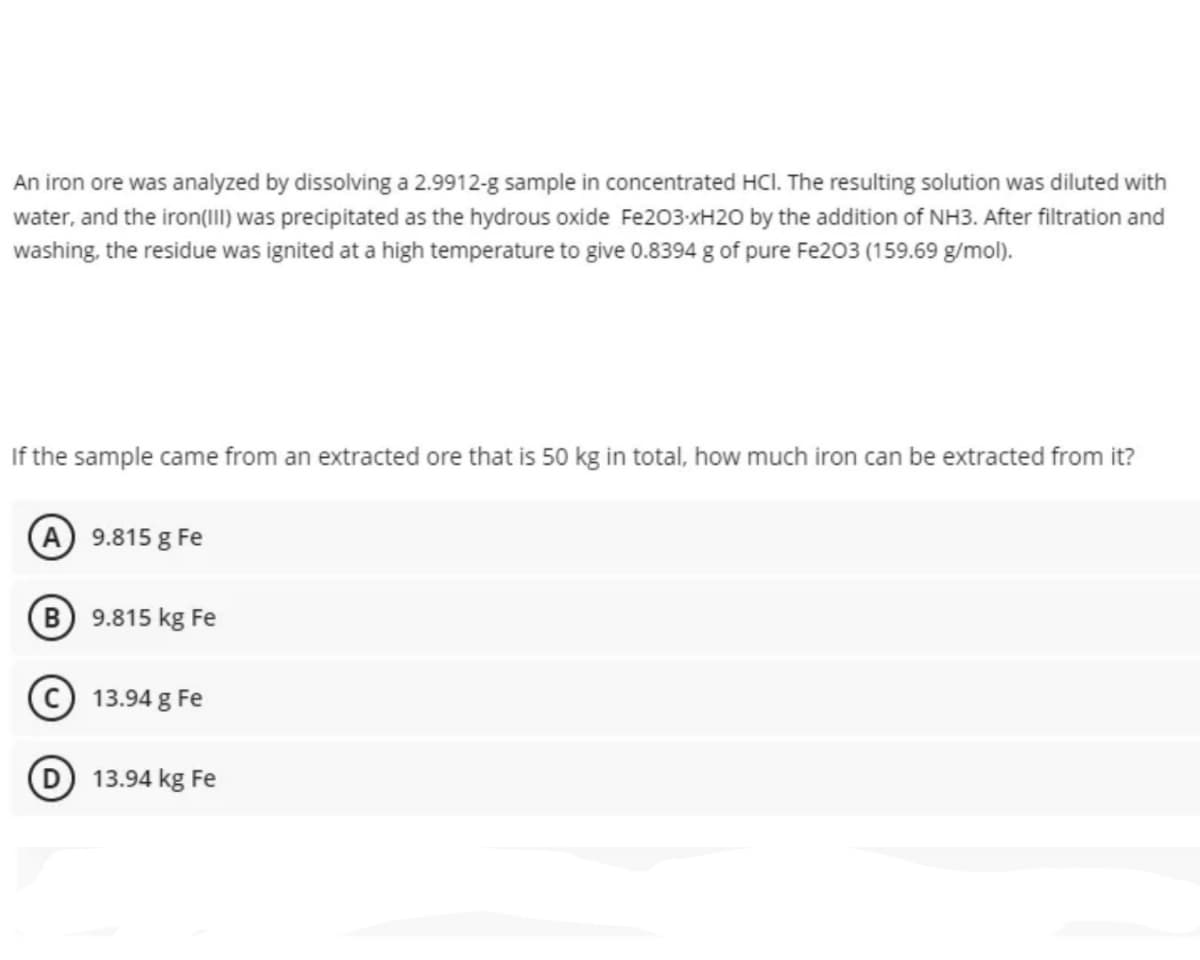An iron ore was analyzed by dissolving a 2.9912-g sample in concentrated HCI. The resulting solution was diluted with water, and the iron(IlI) was precipitated as the hydrous oxide Fe203-XH20 by the addition of NH3. After filtration and washing, the residue was ignited at a high temperature to give 0.8394 g of pure Fe203 (159.69 g/mol). If the sample came from an extracted ore that is 50 kg in total, how much iron can be extracted from it? A 9.815 g Fe B 9.815 kg Fe 13.94 g Fe 13.94 kg Fe
An iron ore was analyzed by dissolving a 2.9912-g sample in concentrated HCI. The resulting solution was diluted with water, and the iron(IlI) was precipitated as the hydrous oxide Fe203-XH20 by the addition of NH3. After filtration and washing, the residue was ignited at a high temperature to give 0.8394 g of pure Fe203 (159.69 g/mol). If the sample came from an extracted ore that is 50 kg in total, how much iron can be extracted from it? A 9.815 g Fe B 9.815 kg Fe 13.94 g Fe 13.94 kg Fe
Chemistry by OpenStax (2015-05-04)
1st Edition
ISBN:9781938168390
Author:Klaus Theopold, Richard H Langley, Paul Flowers, William R. Robinson, Mark Blaser
Publisher:Klaus Theopold, Richard H Langley, Paul Flowers, William R. Robinson, Mark Blaser
Chapter19: Transition Metals And Coordination Chemistry
Section: Chapter Questions
Problem 11E: Iron (II) can be oxidized to iron (III) by dichromate ion, which is reduced to chromium (III) in...
Related questions
Question

Transcribed Image Text:An iron ore was analyzed by dissolving a 2.9912-g sample in concentrated HCl. The resulting solution was diluted with
water, and the iron(III) was precipitated as the hydrous oxide Fe203-XH2O by the addition of NH3. After filtration and
washing, the residue was ignited at a high temperature to give 0.8394 g of pure Fe203 (159.69 g/mol).
If the sample came from an extracted ore that is 50 kg in total, how much iron can be extracted from it?
A 9.815 g Fe
9.815 kg Fe
13.94 g Fe
13.94 kg Fe
Expert Solution
This question has been solved!
Explore an expertly crafted, step-by-step solution for a thorough understanding of key concepts.
Step by step
Solved in 2 steps

Knowledge Booster
Learn more about
Need a deep-dive on the concept behind this application? Look no further. Learn more about this topic, chemistry and related others by exploring similar questions and additional content below.Recommended textbooks for you

Chemistry by OpenStax (2015-05-04)
Chemistry
ISBN:
9781938168390
Author:
Klaus Theopold, Richard H Langley, Paul Flowers, William R. Robinson, Mark Blaser
Publisher:
OpenStax

Chemistry for Engineering Students
Chemistry
ISBN:
9781337398909
Author:
Lawrence S. Brown, Tom Holme
Publisher:
Cengage Learning

Chemistry: An Atoms First Approach
Chemistry
ISBN:
9781305079243
Author:
Steven S. Zumdahl, Susan A. Zumdahl
Publisher:
Cengage Learning

Chemistry by OpenStax (2015-05-04)
Chemistry
ISBN:
9781938168390
Author:
Klaus Theopold, Richard H Langley, Paul Flowers, William R. Robinson, Mark Blaser
Publisher:
OpenStax

Chemistry for Engineering Students
Chemistry
ISBN:
9781337398909
Author:
Lawrence S. Brown, Tom Holme
Publisher:
Cengage Learning

Chemistry: An Atoms First Approach
Chemistry
ISBN:
9781305079243
Author:
Steven S. Zumdahl, Susan A. Zumdahl
Publisher:
Cengage Learning

Chemistry & Chemical Reactivity
Chemistry
ISBN:
9781133949640
Author:
John C. Kotz, Paul M. Treichel, John Townsend, David Treichel
Publisher:
Cengage Learning

Chemistry & Chemical Reactivity
Chemistry
ISBN:
9781337399074
Author:
John C. Kotz, Paul M. Treichel, John Townsend, David Treichel
Publisher:
Cengage Learning

General Chemistry - Standalone book (MindTap Cour…
Chemistry
ISBN:
9781305580343
Author:
Steven D. Gammon, Ebbing, Darrell Ebbing, Steven D., Darrell; Gammon, Darrell Ebbing; Steven D. Gammon, Darrell D.; Gammon, Ebbing; Steven D. Gammon; Darrell
Publisher:
Cengage Learning